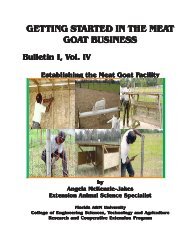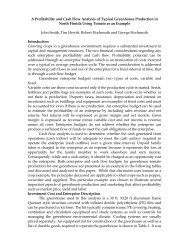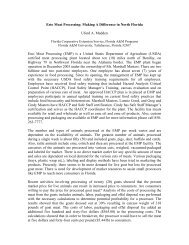Cut Kale: A Blooming Success
Cut Kale: A Blooming Success
Cut Kale: A Blooming Success
Create successful ePaper yourself
Turn your PDF publications into a flip-book with our unique Google optimized e-Paper software.
NC STATE UNIVERSITYFloriculture Research<strong>Cut</strong> <strong>Kale</strong> - A <strong>Blooming</strong> <strong>Success</strong>Lane Greer, James L. Gibson, John M. Dole, and Brian E. WhipkerNCSU Floriculture Research and Extension<strong>Cut</strong>flower kale (Brassica oleracea) is still a noveltyto most U.S. cut flower growers, but breeders andEuropean florists are touting the versatility of thisunique cut. Popular cultivars include Sunset(pinkish-red), Sunrise (creamy white), and WhiteCrane (a hybrid between pink and white). Becausekales mature in autumn, they provide diversity tolate-season arrangements. Retail prices for cut kalerange from $1.50 to $2.50 per stem, and storage andvase life are reported to be excellent. Because thistype of cut flower has great potential for NorthCarolina, we conducted field research in the fall of2001 and 2002.Figure 1. The large heads of cut kale add instantimpact to any bouquet.Production Schedule<strong>Cut</strong> kale needs about 75 days of growth beforecool temperatures begin. In North Carolina,this means that seed should be sown around 21June. We recommend using a germinationmix with excellent water holding capacity in105 or 128-cell plug trays. Recommendedgermination temperatures are 70-75…F. After 2to 3 weeks, plugs should be transplanted intolarge cell packs (72-cell or larger) or pots. Weused 5-inch pots, but this may mean lowerprofitability due to increased time in thegreenhouse, and plants this large will need tobe staked. Transplanting smaller plants to thefield will require more attention to irrigation,however. Ginny Kristl, a grower at Johnny sSelected Seeds in Maine, transplanted 105-plugs directly to the field, but this would bevery difficult to do in North Carolina becauseof the potential for heat and water stress whichcan occur during our summers.Transplanting to the field should occur no laterthan the second week of August. This providesenough time for stem elongation, since growthgenerally slows down with the onset of coolnight temperatures (below 60…F). Colorationof the upper-central leaves occurs when cooltemperatures break down chlorophyll and allowthe white, pink, or red color to be expressed.© 2003 North Carolina State University1
Because transplanting occurs later in the summer,irrigation must be provided. Insufficient moisturewill cause shorter stems and leaf drop. Drip tapeis recommended for field production of most cutflowers because it decreases the occurrence ofBotrytis and conserves water.Netting or staking is necessary for straight stems.We staked the plants while they were in pots inthe greenhouse, then used netting in the field.One row of netting is sufficient, and this can bepulled up as the plants grow. Lower leavesshould be removed periodically during growth,which makes netting and insect control easier.Most netting designed for cut flowers is on a 6x6-inch grid, so plant spacing should match thenetting grid size.In 2002, we sought to increase stem length byapplying gibberellic acid (GA) to plants. GA isa plant hormone that is responsible for cellelongation. We tested 10, 20, 40, 80, and 100ppm GA (Pro-Gibb, Valent Chemical Corp.).Height, color quality, and overall visual plantquality were not affected by any concentration ofGA. However, we do not feel that the summer of2002 was typical for North Carolina, whichexperienced the worst drought in recent memory.Additionally, the field where the kale was grownwas infested with Pythium, so we saw moredamage from root rot than would normally beexperienced. To compound these problems, orperhaps, because of them, we experiencedextremely heavy pressure from insects,particularly cabbage loopers. Furthermore, wefeel that the efficacy of GA would have beengreatly enhanced by the addition of a surfactant.<strong>Kale</strong> leaves are very thick and waxy and thusrepel water. A surfactant would break this surfacetension and allow the GA to be absorbed by theplant. Capsil (Scotts Co., Marysville, Ohio), aspray adjuvant, has been shown to improve uptakeof plant growth regulators (Peter Konjoian,personal communication) and may provebeneficial for cut kale.Figure 2. <strong>Cut</strong> kale plots during the growing (left)and harvesting (right) stages.More on Stem LengthOne of the major concerns with cut kale is how toproduce long, straight stems. Mature height ofcut kale is reported to be 24 inches. In trialsconducted at NC State in 2001, stem heightranged from 9 to 23 inches, with 16 inches beingthe average stem length when plants were placedat the recommended 6x6-inch spacing. We sawslightly increased stem length with 8x8-inch plantspacing (avg. = 19 inches), and decreased stemlength with 4x4-inch spacing (avg. = 14 inches).Figure 3. Without cool night temperatures (below60…F), cut kale cannot develop its characteristicbloom of color in the central leaves. The stem onthe right was produced in a greenhouse.2
FertilizationContainerized plants should receive fertilizer atthe nitrogen (N) rate of 100-150 ppm, constantliquid feed. Broadcast ammonium nitrate at theN rate of 150-200 ppm to the field beforetransplanting seedlings. For more specificrecommendations on nutrition, see <strong>Success</strong> withOrnamental Cabbage and <strong>Kale</strong> (HIL #507) athttp://www.ces.ncsu.edu/depts/hort/floriculture/crop/crop_kale.htm.Pest ManagementThe primary pests of cut kale are cabbage loopersand imported cabbageworms, both caterpillarsthat can be controlled with Bacillus thuringiensis(Dipel), azadirachtin (Azatin), permethrin (Astro),or carbaryl (Sevin). Refer to <strong>Success</strong> withOrnamental Cabbage and <strong>Kale</strong> (HIL #507) athttp://www.ces.ncsu.edu/depts/hort/floriculture/crop/crop_kale.htm for information on other pests.Recommended Reading:Kristl, Ginny. 2001. From ‘Sunrise’ to ‘Sunset’:Growing the new cutflower kales. <strong>Cut</strong> FlowerQuarterly 13(3):5.Whipker, Brian E., James L. Gibson, RaymondA. Cloyd, C. Ray Campbell, and Ron Jones.1998. <strong>Success</strong> with Ornamental Cabbage and<strong>Kale</strong> (HIL #507). http://www.ces.ncsu.edu/depts/hort/floriculture/crop/crop_kale.htm.Acknowledgements: The authors would like tothank Ingram McCall for her technical assistanceand Valent Chemical Corp. for their contributionof Pro-Gibb. We would also like to thank ScottsCo. for supplying the soluble fertilizer and FafardCo. for supplying the root substrate.Figure 4. Long, straight stems are a goal of cutkale production.Figure 5. Fully colored, mature stems of ‘Sunrise’show pink, red, and purple hues.Figure 6. From left to right, these stems are considered excellent, good, and fair, and the last two areunsalable.3






![[PDF] Small Farm Digest Fall 2007 - National Institute of Food and ...](https://img.yumpu.com/52370664/1/190x245/pdf-small-farm-digest-fall-2007-national-institute-of-food-and-.jpg?quality=85)




